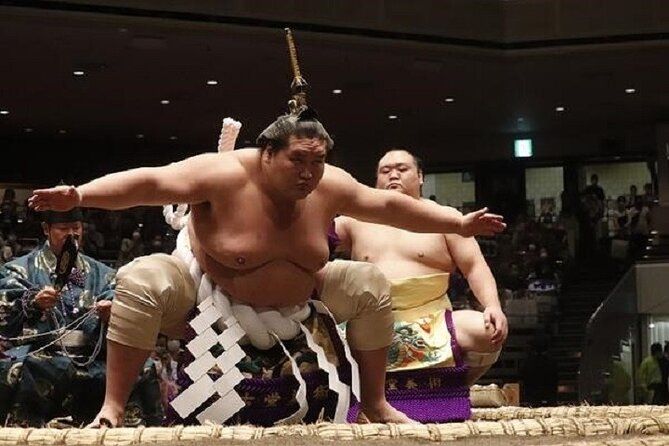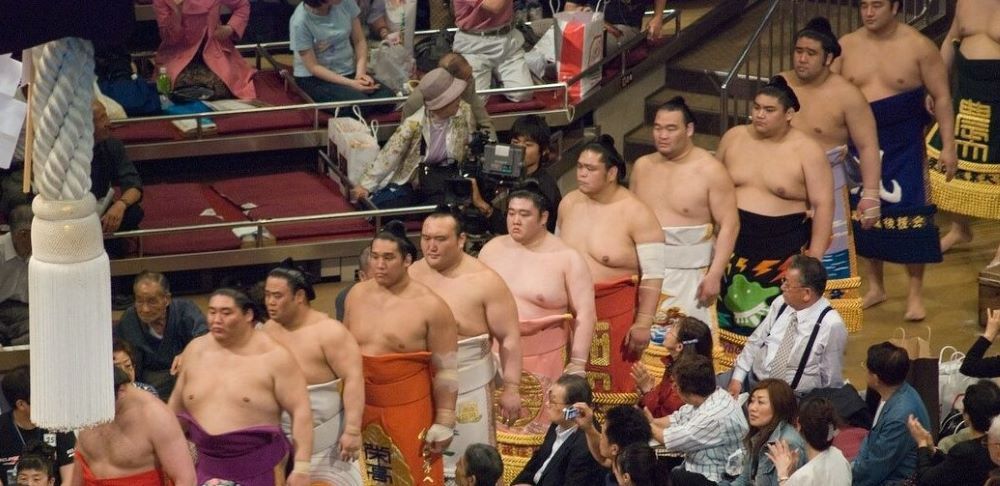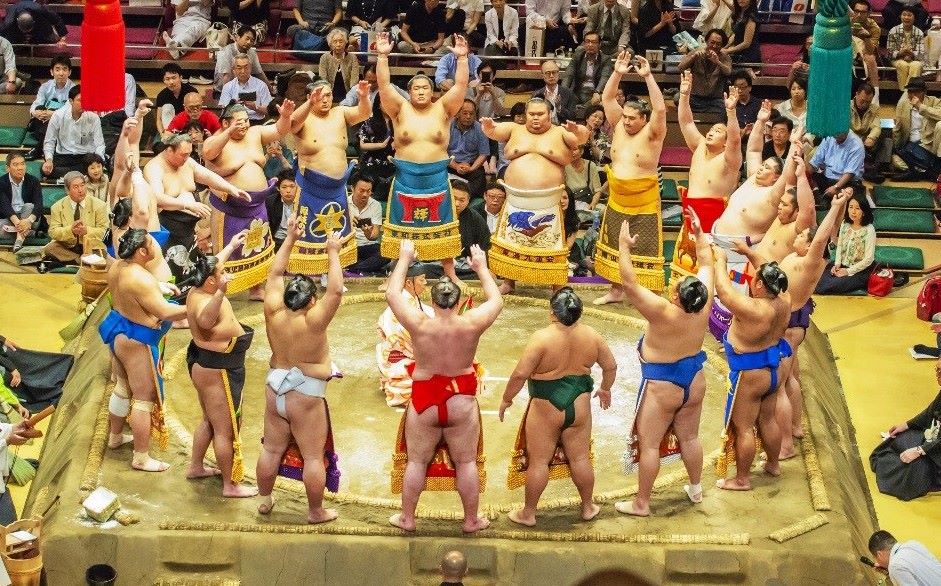Sumo wrestling, or sumo, is a traditional Japanese sport that has been around for centuries. It is a unique form of wrestling that involves two wrestlers, or rikishi, who try to push each other out of a circular ring or dohyo. Sumo is not just a sport, but also a cultural and religious practice that is deeply ingrained in Japanese society.
The origins of sumo can be traced back to ancient Shinto rituals, where it was believed that the gods would be pleased by displays of strength and power. Over time, sumo evolved into a more formalized sport with rules and regulations. Today, sumo wrestlers are revered as national heroes in Japan, and the sport has gained popularity around the world.

History of Sumo
Sumo is a traditional Japanese sport that dates back over 1,500 years. It is believed to have originated as a form of ritual dance performed at Shinto shrines to entertain the gods and ensure a bountiful harvest. Over time, the dance evolved into a more physical form of competition, eventually becoming the sport we know today.
Sumo was originally practiced by the samurai class, who used it as a way to train for combat. It was also popular among the common people, who enjoyed watching the matches and betting on the outcomes. In the Edo period (1603-1868), sumo became a professional sport, with wrestlers organized into stables and competing in tournaments for cash prizes.
It has undergone many changes over the years, both in terms of its rules and its popularity. In the early 20th century, the sport was modernized to make it more accessible to a wider audience. The introduction of weight classes and the use of a ring with defined boundaries were among the changes made during this time.
Today, sumo is one of Japan’s most popular sports, with millions of fans both in Japan and around the world. The sport’s top wrestlers, or yokozuna, are national celebrities, and tournaments are broadcast on television to millions of viewers.
Rules and Regulations
Sumo has its own set of rules and regulations that govern how matches are conducted and how wrestlers are ranked.
Each match, or bout, takes place in a circular ring called a dohyo. The objective of the match is to force your opponent out of the ring or to make them touch the ground with any part of their body other than the soles of their feet. Matches typically last only a few seconds, but can sometimes go on for minutes.
There are six divisions of sumo wrestlers, each with its own ranking system. Wrestlers are promoted or demoted based on their performance in tournaments, which take place six times a year. The highest rank a wrestler can achieve is yokozuna, which is reserved for only the best of the best.
Sumo wrestlers are also subject to strict rules regarding their behavior both inside and outside the ring. They are expected to maintain a certain level of decorum and respect for their opponents, and any breach of these rules can result in penalties or even disqualification.
Sumo Wrestlers

Sumo wrestlers are some of the most well-known athletes in Japan, and they are revered for their dedication to the sport and their impressive physiques.
Sumo wrestlers are typically very large individuals, with some weighing over 400 pounds. Despite their size, they are surprisingly agile and quick on their feet. They train for many years to develop the strength and technique necessary to compete at a high level.
The wrestlers are divided into different weight classes, with the heaviest wrestlers competing in the top division. The top division is known as the makuuchi division, and it is where the best sumo wrestlers in the world compete.
They also have a strict training regimen that includes a combination of weightlifting, cardio, and sumo-specific exercises. They also follow a strict diet that is high in protein to help them maintain their weight and build muscle. The hot pot dish known as Chanko Nabe is a famed sumo food and you can try it at many places around tokyo, especially in the Ryogoku district of Tokyo.
Training and Preparation
Sumo wrestlers are known for their impressive size and strength, but their success on the dohyo (sumo ring) is not just a result of their natural abilities. It takes years of rigorous training and preparation to become a professional sumo wrestler.
Training typically begins at a young age, with many wrestlers joining a stable (training group) as teenagers. The daily routine for a sumo wrestler includes hours of practice, weight training, and a strict diet to maintain their size and strength.
One of the most important aspects of sumo training is mastering the techniques used in matches. These techniques include throws, trips, and shoves, and require a combination of strength, agility, and strategy. Wrestlers often spend hours practicing these techniques with their stablemates and under the guidance of their stablemaster.
Another key component of sumo training is mental preparation. Wrestlers must be able to maintain focus and composure during matches, despite the intense physical and emotional pressure. To develop this mental toughness, many wrestlers practice meditation and visualization techniques.
Overall, becoming a successful sumo wrestler requires a combination of physical strength, technical skill, and mental fortitude. Through years of dedicated training and preparation, wrestlers are able to achieve the level of success that makes sumo one of the most revered sports in Japan.
More: How To Watch Sumo Training Practice In Tokyo
Sumo Tournaments

Grand Sumo tournaments, or basho, are held six times a year in Japan. Each tournament lasts for 15 days and is held in different cities across the country. The tournaments are organized by the Japan Sumo Association and attract thousands of fans from all over the world.
The tournaments are divided into six divisions, with the top division being the most prestigious. The top division consists of 42 wrestlers, or rikishi, who compete for the championship title. The wrestlers are ranked based on their performance in the previous tournament, with the highest-ranked wrestler, or yokozuna, at the top of the rankings.
Each day of the tournament, the wrestlers compete in one match against another wrestler in their division. The matches take place in a dohyo, a raised ring made of clay and covered in sand. The objective is to force the opponent out of the ring or make them touch the ground with any part of their body other than the soles of their feet.
The tournament culminates in the final day, or senshuraku, where the wrestler with the most wins is crowned the champion. The championship title is highly coveted and brings prestige and fame to the winner. The winner also receives a large cash prize and is often invited to meet with dignitaries and attend special events.
Sumo tournaments are not just about the matches, but also about the atmosphere and culture surrounding the sport. Fans dress up in traditional clothing and bring banners and flags to cheer on their favorite wrestlers. Food stalls and souvenir shops are set up outside the tournament venue, offering a wide range of sumo-related merchandise and snacks.
Attending a sumo tournament is a memorable experience that offers a glimpse into the fascinating world of sumo wrestling and Japanese culture.
More: Sumo Grand Tournaments: Schedules, Best Tickets & How To Watch
Sumo Outside of Japan
While sumo is most commonly associated with Japan, the sport has gained popularity outside of its home country in recent years.
One of the biggest events in the sumo calendar outside of Japan is the World Sumo Championships, which has been held annually since 1992. The competition attracts top sumo wrestlers from around the world and is a chance for non-Japanese wrestlers to showcase their skills on the international stage.
Sumo has also been introduced in schools and universities in countries such as the United States, Canada, and Australia, where it is seen as a fun and unique way to stay active and learn about Japanese culture.
In addition, countries have their own national sumo associations, such as the United States Sumo Federation and the Canadian Sumo Federation, which organize tournaments and events throughout the year.
While sumo may never reach the same level of popularity outside of Japan as it does within the country, its growing presence around the world is a testament to the sport’s enduring appeal and unique cultural significance.
Controversies in Sumo
Sumo wrestling is a sport steeped in tradition and history. However, it has not been immune to controversy over the years. Here’s a few of the most notable controversies in sumo:
Match-Fixing Scandals
Match-fixing scandals have plagued sumo wrestling for decades. In 2011, a major scandal rocked the sport when wrestlers were found to have been involved in match-fixing. The scandal resulted in the cancellation of a tournament for the first time in 65 years.
Weight Gain Controversy
Sumo wrestlers are known for their large size and impressive physiques. However, there has been controversy over the years about the methods that some wrestlers use to gain weight. Some wrestlers have been accused of using illegal substances or engaging in unhealthy practices to gain weight quickly.
Violence and Bullying
There have been high-profile cases of violence and bullying in the sumo world. In 2007, a popular wrestler was forced to retire after he was caught on camera assaulting a junior wrestler. In 2018, another wrestler was accused of bullying a younger wrestler, resulting in a six-tournament suspension.
Gender Discrimination
Sumo wrestling is a male-dominated sport, and women are not allowed to compete professionally. This has led to accusations of gender discrimination and calls for the sport to be more inclusive.
Conclusion
Despite these controversies, sumo wrestling remains a beloved and respected sport in Japan. While there is always room for improvement, the sumo world has taken steps to address these issues and uphold the integrity of the sport.






